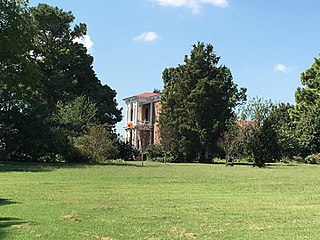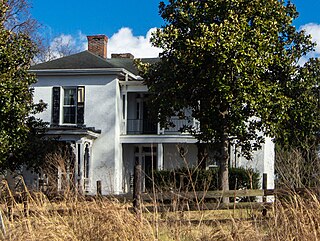
Andrew Nelson Lytle was an American novelist, dramatist, essayist and professor of literature.
This is a list of properties and historic districts in Tennessee that are listed on the National Register of Historic Places. There are over 2,000 in total. Of these, 29 are National Historic Landmarks. Each of Tennessee's 95 counties has at least one listing.

Sudley Place is a historic mansion in Robertson County, Tennessee, U.S.. It was built in 1856 for Samuel Bowling Brown, a whiskey distiller. It was purchased by the Fuqua family in the 1930s. Democratic politician Jesse H. Jones, who served as the 9th United States Secretary of Commerce from 1940 to 1945, grew up in the house.

Wessyngton is a historic mansion on a former tobacco plantation in Cedar Hill, Tennessee, U.S. It is listed on the National Register of Historic Places.

Rock Jolly is a historic house near Cross Plains, Tennessee, U.S..

The Thomas C. Black House, also known as Old Black Place, is a historic house in Murfreesboro, Tennessee, U.S..
Caff-E-Hill Farm is a historic farmhouse in Readyville, Tennessee, U.S..

The Childress-Ray House is a historic house in Murfreesboro, Tennessee, U.S. It was built in 1847. In 1874, it was purchased by John Childress, the brother of U.S. First Lady Sarah Childress Polk, brother-in-law of U.S. President James K. Polk, and the father-in-law of Tennessee Governor John C. Brown. Former First Lady Sarah Polk was a frequent visitor.

The John C. Spence House is a historic house in Murfreesboro, Tennessee, U.S.. It was the fraternity house of the MTSU Pike chapter from 1974 to 1981.
The Dement House, also known as Colonial Acres, is a historic house in Lascassas, Tennessee, U.S.. It was first built as a log cabin by Abner Dement, the son of a French immigrant and slaveholder, in 1817. When Abner was murdered by one of his slaves in 1825, the cabin was inherited by his son John, who lived here with his wife Christine Overall. The couple hired Arch Hite to turn the cabin into a two-story house with a portico designed in the Greek Revival architectural style in 1833. The house has been listed on the National Register of Historic Places since June 25, 1986.
The Enoch H. Jones House, also known as the Harvey House, is a historic house in Murfreesboro, Tennessee, U.S.. It was built as a log cabin in 1796 for Ezra Jones, his wife Margaret Hunt and their six children. Their son Enoch served in the War of 1812 and married Eunice Macklin, with whom he had six children. He owned 14 slaves by 1840, and he was active in the Whig Party. By 1850, he redesigned the cabin as an I-house with a portico in the Greek Revival architectural style. The house has been listed on the National Register of Historic Places since August 25, 1995.
The William B. Jordan Farm is a historic farmhouse in Eagleville, Tennessee, U.S..
Greenfield, also known as the David Chenault Home, is a historic farmhouse in Castalian Springs, Tennessee, U.S..

The Daniel Smith Donelson House, also known as Eventide, is a historic house in Hendersonville, Tennessee, U.S..
The James B. Jameson House, also known as the Jameson-Harsh House, is a historic house in Gallatin, Tennessee, U.S..

Locust Grove is a historic house in Castalian Springs, Tennessee, U.S.. It was built in 1817 for Francis Weathered, a veteran of the American Revolutionary War and Baptist preacher. The house was designed in the Federal architectural style. It has been listed on the National Register of Historic Places since January 8, 1979.

Wall Spring, also known as Elliott Springs, is a historic mansion on a farm in Gallatin, Tennessee, U.S.. It was a horse farm in the Antebellum Era.

The Trousdale-Baskerville House, also known as Baskerville House and Maywood, is a historic house in Gallatin, Tennessee, U.S..
Oakland is a historic mansion on a farm in Gallatin, Tennessee, U.S.. It was built circa 1850 by John Fontville, who also built the James B. Jameson House in Gallatin and Greenfield in Castalian Springs. The original owner, Daniel Wade Mentlo, was a physician who owned 23 slaves in 1850.









